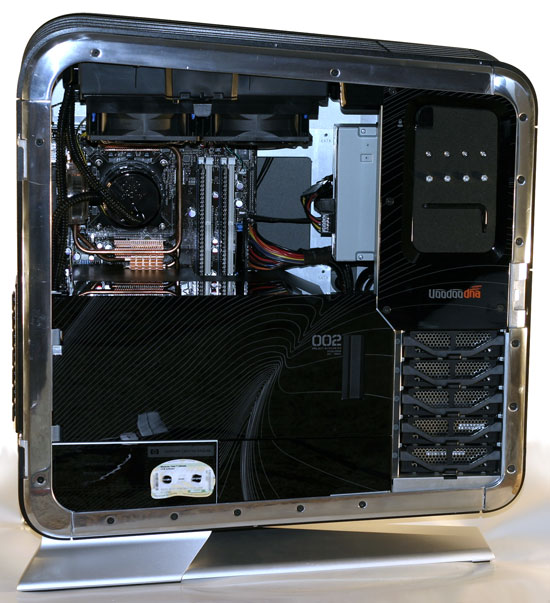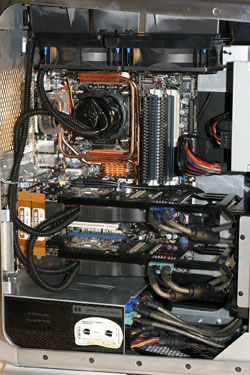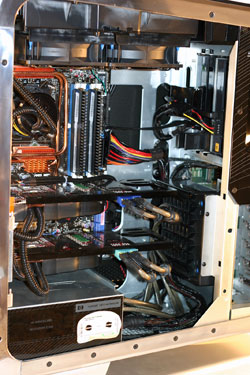Blackbird 002, Take Two
One of the most impressive aspects about the Blackbird is undoubtedly the case design. This isn't just your typical rectangular computer case with a window, some lights, a design cut into the metal, and a fancy paint job. As we mentioned in the previous article, the fully assembled case is quite heavy, but it's also extremely sturdy. The case is made from cast aluminum, and the main structure is extremely thick aluminum. The system we were shipped weighs about 70 pounds, and while the liquid cooling certainly accounts for some of the weight, the thick shell is the primary contributor.
One of the aspects of the case that we didn't mention previously (in part because we weren't aware of this fact at the time) is that the case door can actually be easily removed. Swing the door open and lift up on it and you can pull it off the pins and set it aside while you access the internals. Because of the heavy-duty design, this can all be accomplished without compromising structural integrity.
Other than looking cool and weighing a lot, the design of the case does serve other purposes. First, the raised chassis opens up a sixth side of cooling: air can now come in the bottom of the case. This may not be strictly necessary, but with the compartmental design that HP has created the bottom intake provides fresh air to the power supply.
The purpose of the compartmentalized design is to provide optimal cooling to all of the major components without creating a bunch of turbulence, so the internals are broken up into three main sections: at the bottom is the power supply, in the middle are the expansion cards, and at the top we find the CPU and water cooling system. The hard drives are located towards the front of the chassis and cooled by an internal 120mm fan that also provides airflow to the expansion cards. Having this fan located several inches inside the chassis allows it to provide airflow without generating much in the way of audible noise.
The panel that holds the expansion cards in place swings open with a quick release of the latch, and like the main door this can also be removed. Other plastic panels that help divide the interior into compartments can also be removed, and with all of these out of the way users get quick and easy access to the internals.
Upgrading expansion cards - outside of dealing with the water cooling on the GPU(s) if you get the LCi version - adding or removing hard drives, or swapping out the secondary optical drive can all be done in a matter of minutes without ever needing to touch a tool. We've seen plenty of tool-less case designs over the years, but without a doubt this is one of the slickest approaches that we've ever had the pleasure of using. It's also important to remember that even with the unique case construction, all the components contained within the Blackbird are all standard ATX offerings.
All of this raises some interesting points of discussion in regards to the case. Assuming that the cumbersome weight isn't a problem - it will be for some people but not for others - how much are we actually talking about spending on just the case? A lot of people are perfectly happy with the typical Antec and Cooler Master budget cases, but some people want a truly high-quality case like a Lian Li and they're willing to spend several hundred dollars if necessary. Will it be possible for users to simply bypass HP and purchase the case separately? (For now, the answer is no, but if enough people are interested HP might have a change of heart.) If you're looking at building a completely new high-end computer anyway, however, that might not even be necessary provided that HP's prices are reasonable. So how does HP's pricing of the Blackbird compare with a DIY build?
One of the most impressive aspects about the Blackbird is undoubtedly the case design. This isn't just your typical rectangular computer case with a window, some lights, a design cut into the metal, and a fancy paint job. As we mentioned in the previous article, the fully assembled case is quite heavy, but it's also extremely sturdy. The case is made from cast aluminum, and the main structure is extremely thick aluminum. The system we were shipped weighs about 70 pounds, and while the liquid cooling certainly accounts for some of the weight, the thick shell is the primary contributor.
 |
One of the aspects of the case that we didn't mention previously (in part because we weren't aware of this fact at the time) is that the case door can actually be easily removed. Swing the door open and lift up on it and you can pull it off the pins and set it aside while you access the internals. Because of the heavy-duty design, this can all be accomplished without compromising structural integrity.
Other than looking cool and weighing a lot, the design of the case does serve other purposes. First, the raised chassis opens up a sixth side of cooling: air can now come in the bottom of the case. This may not be strictly necessary, but with the compartmental design that HP has created the bottom intake provides fresh air to the power supply.
 |
The purpose of the compartmentalized design is to provide optimal cooling to all of the major components without creating a bunch of turbulence, so the internals are broken up into three main sections: at the bottom is the power supply, in the middle are the expansion cards, and at the top we find the CPU and water cooling system. The hard drives are located towards the front of the chassis and cooled by an internal 120mm fan that also provides airflow to the expansion cards. Having this fan located several inches inside the chassis allows it to provide airflow without generating much in the way of audible noise.
 |
 |
The panel that holds the expansion cards in place swings open with a quick release of the latch, and like the main door this can also be removed. Other plastic panels that help divide the interior into compartments can also be removed, and with all of these out of the way users get quick and easy access to the internals.
Upgrading expansion cards - outside of dealing with the water cooling on the GPU(s) if you get the LCi version - adding or removing hard drives, or swapping out the secondary optical drive can all be done in a matter of minutes without ever needing to touch a tool. We've seen plenty of tool-less case designs over the years, but without a doubt this is one of the slickest approaches that we've ever had the pleasure of using. It's also important to remember that even with the unique case construction, all the components contained within the Blackbird are all standard ATX offerings.
All of this raises some interesting points of discussion in regards to the case. Assuming that the cumbersome weight isn't a problem - it will be for some people but not for others - how much are we actually talking about spending on just the case? A lot of people are perfectly happy with the typical Antec and Cooler Master budget cases, but some people want a truly high-quality case like a Lian Li and they're willing to spend several hundred dollars if necessary. Will it be possible for users to simply bypass HP and purchase the case separately? (For now, the answer is no, but if enough people are interested HP might have a change of heart.) If you're looking at building a completely new high-end computer anyway, however, that might not even be necessary provided that HP's prices are reasonable. So how does HP's pricing of the Blackbird compare with a DIY build?










33 Comments
View All Comments
EateryOfPiza - Tuesday, October 2, 2007 - link
that custom bios might be something special, or maybe its a drag on performance.JarredWalton - Tuesday, October 2, 2007 - link
I would be absolutely shocked if performance was more than 3% off with the latest drivers. As it stands, the version of the Blackbird I have for testing has HD 2900 CrossFire, and I think most people would be better off getting 8800 GTX SLI. Even Rahul said, "It's not just about the benchmarks anymore - it's about the experience." Basically, a lot of companies got hung up on oneupmanship, where they would be the "best" in some magazine review, but only by 2%. It's pretty silly, I think.themadmilkman - Tuesday, October 2, 2007 - link
How long until somebody makes a knock-off of the case design? I'd be interested in one.kmmatney - Tuesday, October 2, 2007 - link
One will probably come out of China before the HP one is available...Bonesdad - Tuesday, October 2, 2007 - link
but it might kill your dogOwls - Tuesday, October 2, 2007 - link
I know you are trying to make a comparison to hand built quality but it was a bit over the top. The Duesenberg is a classic and a symbol of craftsmanship in the meantime, cases and parts made in china assembled by hand does not equal classic or "well built" by any means. How many cases have you seen that are "classics" today?Probably none.
good article though :)
strikeback03 - Tuesday, October 2, 2007 - link
I'd imagine the point is that back in the day whoever bought that Duesenberg new was not buying a classic at the time either, just a nice expensive, well built car.psychotix11 - Tuesday, October 2, 2007 - link
I would have thought after the foot-in-mouth "it takes $300 to match or beat air cooling" you guys would have had the tact to leave it alone and accept that you really don't know what you're talking about, but of course you couldn't resist the chance to take another dig at it on your crusade for air cooling, bias at it's finest, tomshardware would be proud of you.That said from what I can see they are using a dual 120mm radiator to cool two ultras and an over clocker quad core, that isn't enough. A dual 120mm rad will cool either an OC'd quad or the dual GPU's, but with both in a single loop it's not going to be enough even if you slap some delta screamers on it and let your ears bleed. You're going to need a triple 120mm for that.
kmmatney - Tuesday, October 2, 2007 - link
rolls eyes...JarredWalton - Tuesday, October 2, 2007 - link
Read what you just wrote: "...they are using a dual 120mm radiator to cool two ultras and an over clocker quad core, that isn't enough. A dual 120mm rad will cool either an OC'd quad or the dual GPU's, but with both in a single loop it's not going to be enough..."Let's talk bias for a second. Suggesting that a $300+ cooling arrangement with dual 120mm fans is not enough cooling and that *more* is required for proper water cooling of this setup illustrates the exact problem. I can get similar results from air cooled GPUs and CPUs for 1/4 the price (on the cooling side of things). Actually, it's even worse on GPUs, as the stock air coolers are "free" and water blocks are just pure expense that may not really even impact performance. Even if a triple-fan WC setup is slightly better in terms of overall cooling, that doesn't make it a great choice. Now read what I *actually* said again:
"We decided to simply skip out on water cooling, as our own testing has been less than stellar and we're finding that top-quality air cooling is still more than sufficient for the vast majority of people."
Yes, that's a terrible slam on water cooling: we find air cooling to be more than sufficient for most people. Or if you want to reverse it, water cooling is really only "necessary" for a very small portion of the market. Just like I specifically recommended AGAINST spending $1100 on a QX6850 and instead chose a Q6600 that will beat the pants off it on price and will overclock nearly as far, I chose air cooling that will cost significantly less and overclock nearly as far. While we're at it, I chose 8800 GTX cards that cost less than the 8800 Ultras and will run nearly as fast. See the pattern?
For the record, the water cooling in the Blackbird does a fine job at keeping the entire system running, and I didn't have any issues with temperatures or escalating noise levels. Without putting a similar setup into the case without water cooling and running benchmarks, I can't say for sure how much of an impact their cooling design has on overall performance and noise levels. However, if I'm building a system for myself or a friend, liquid cooling is just another expense and hassle that I'm going to avoid. I avoid RAID 0 configurations for the same reason.
Water is more complex and creates more concerns (weight, potential for leaks, installation and upgrade time and effort). Is it bad? Nope. Just like a $5500 prebuilt isn't bad, and a factory overclocked system isn't bad. It's still an expense many will bypass.